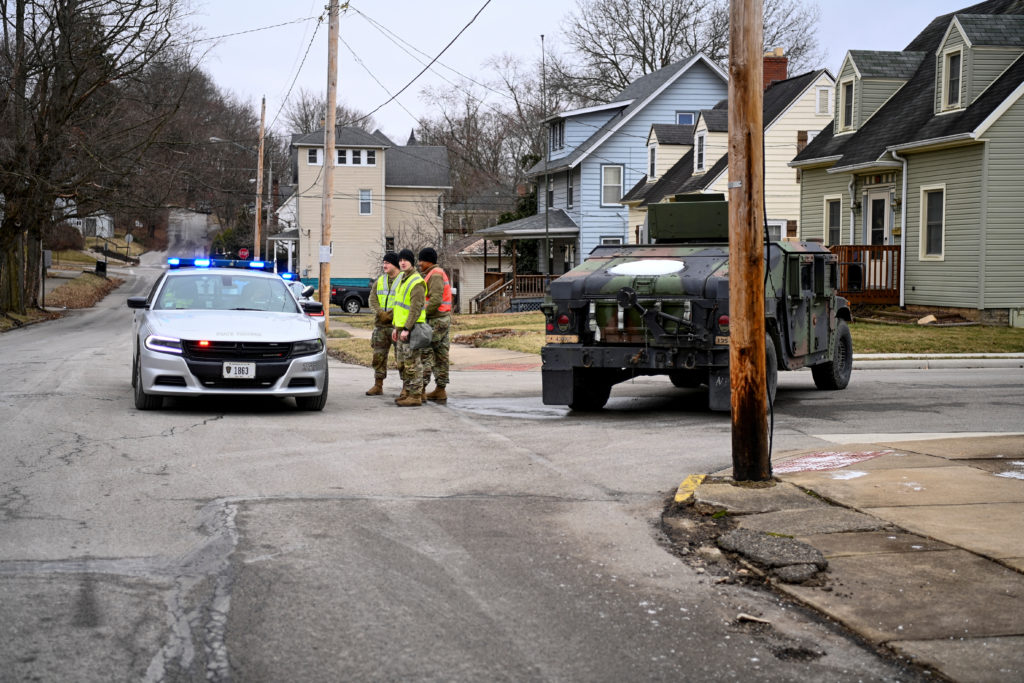Persistent Toxic Chemicals: The Ohio Train Derailment's Ongoing Impact On Buildings

Table of Contents
Assessing the Extent of Contamination
Determining the full extent of building contamination following the release of persistent toxic chemicals presents significant challenges. The widespread nature of the dispersal, coupled with the insidious nature of many of these compounds, necessitates a multi-faceted approach to assessment. Thorough testing is crucial to understand the level of contamination in affected areas. This involves several key steps, often requiring collaboration with Environmental Protection Agencies (EPA) and other regulatory bodies.
- Air quality testing: This is crucial for identifying volatile organic compounds (VOCs) like vinyl chloride, which can remain airborne for extended periods. Advanced sampling techniques are needed to accurately measure concentrations.
- Soil testing: Assessing soil contamination is essential, as persistent toxic chemicals can leach into the ground and subsequently migrate into building foundations and structures. This testing identifies heavy metals and persistent organic pollutants (POPs).
- Building material testing: This involves analyzing various building components – bricks, wood, concrete, plastics, and paints – for the absorption and retention of persistent toxic chemicals. This helps determine the extent of material degradation and the need for remediation.
The EPA plays a vital role in overseeing testing protocols and establishing acceptable limits for various contaminants. Their guidelines and expertise are essential in guiding remediation efforts and ensuring public safety.
Long-Term Effects on Building Materials
Persistent toxic chemicals can cause significant and long-lasting damage to building materials. The degradation process varies depending on the specific chemical and the material involved, leading to a range of problems.
- Vinyl chloride: This potent carcinogen can weaken and degrade plastics, particularly PVC pipes, compromising their structural integrity and potentially leading to leaks or failures.
- Butyl acrylate: This chemical can damage paints and coatings, leading to peeling, discoloration, and potential release of harmful substances.
- Concrete and other structural components: Exposure to certain persistent toxic chemicals can compromise the strength and durability of concrete and other structural elements, increasing the risk of structural instability and safety hazards. Long-term effects may include corrosion and weakening of the building's framework.
The long-term consequences of material degradation may not be immediately apparent but can pose serious safety risks over time. Regular inspections and testing are crucial to identify potential issues early on.
Health Risks Associated with Contaminated Buildings
Exposure to persistent toxic chemicals in contaminated buildings presents significant health risks, both in the short-term and long-term. The severity of the effects depends on factors such as the concentration of the chemicals, duration of exposure, and individual susceptibility.
- Respiratory problems: Inhaling VOCs like vinyl chloride can cause immediate respiratory irritation and, with prolonged exposure, lead to more serious conditions such as asthma or lung cancer.
- Skin irritation: Contact with contaminated surfaces can cause skin irritation, rashes, and other dermatological problems.
- Long-term health risks: Exposure to many persistent toxic chemicals has been linked to various cancers, neurological disorders, and reproductive problems. The long-term impacts of low-level exposure are still being researched, but the potential for serious health consequences is undeniable.
Proper remediation and mitigation strategies are absolutely essential to minimize these health risks. Implementing effective safeguards protects the health and well-being of building occupants.
Remediation and Mitigation Strategies
Remediating buildings contaminated with persistent toxic chemicals requires a comprehensive and often costly approach. The chosen strategy depends on the type and extent of contamination and the specific materials involved.
- Decontamination: This may involve cleaning affected surfaces, using specialized techniques to remove or neutralize persistent toxic chemicals.
- Removal and replacement: Severely contaminated building components may need to be removed and replaced with new, uncontaminated materials.
- Advanced air filtration: Installing high-efficiency particulate air (HEPA) filtration systems and ensuring proper ventilation helps reduce airborne contaminants.
- Long-term monitoring: Continuous monitoring is crucial to ensure the effectiveness of remediation efforts and identify any potential recurrence of contamination.
The cost and time involved in remediation can be substantial, depending on the complexity of the situation. However, the long-term health and safety benefits far outweigh the expense.
Legal and Insurance Implications
The Ohio train derailment and subsequent contamination raise significant legal and insurance issues for property owners, businesses, and government agencies.
- Liability: Determining liability for property damage and resulting health consequences is a complex legal matter involving multiple parties.
- Insurance coverage: The extent of insurance coverage for remediation costs and related expenses is a crucial consideration for property owners. Policies may vary in their coverage of environmental contamination.
- Potential legal action: Lawsuits against responsible parties are likely, and the legal ramifications can be extensive and protracted.
Navigating these legal and insurance complexities requires specialized expertise, and seeking professional legal and insurance advice is crucial for affected parties.
The Lingering Threat of Persistent Toxic Chemicals
The Ohio train derailment serves as a stark reminder of the devastating and long-lasting impact of persistent toxic chemicals on buildings and communities. Proper assessment, comprehensive remediation, and ongoing monitoring are paramount to mitigating the risks associated with this type of contamination. The potential health consequences and legal ramifications are substantial, underscoring the need for proactive measures to prevent future incidents and minimize the impact of persistent toxic chemical contamination. Learn more about the dangers of persistent toxic chemicals and advocate for stricter regulations and safety measures. If you suspect your building is contaminated, contact your local environmental protection agency or other relevant authorities for assistance.

Featured Posts
-
 Los Angeles Palisades Fire A List Of Celebrities Who Lost Their Homes
Apr 24, 2025
Los Angeles Palisades Fire A List Of Celebrities Who Lost Their Homes
Apr 24, 2025 -
 Los Angeles Palisades Fire A List Of Celebrities Whose Homes Were Damaged Or Destroyed
Apr 24, 2025
Los Angeles Palisades Fire A List Of Celebrities Whose Homes Were Damaged Or Destroyed
Apr 24, 2025 -
 Boost For Hong Kong Chinese Stocks Rally On Reduced Trade Friction
Apr 24, 2025
Boost For Hong Kong Chinese Stocks Rally On Reduced Trade Friction
Apr 24, 2025 -
 Cassidy Hutchinsons Memoir A Jan 6 Witness Speaks Out This Fall
Apr 24, 2025
Cassidy Hutchinsons Memoir A Jan 6 Witness Speaks Out This Fall
Apr 24, 2025 -
 John Travoltas Heartfelt Tribute Photo Marks Late Sons Birthday
Apr 24, 2025
John Travoltas Heartfelt Tribute Photo Marks Late Sons Birthday
Apr 24, 2025
